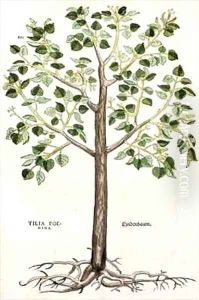Leonhard Fuchs Paintings
Leonhard Fuchs was not an artist in the traditional sense but a German physician and one of the founding fathers of botany, known primarily for his remarkable book on plants, 'De Historia Stirpium Commentarii Insignes' (Notable Commentaries on the History of Plants), published in 1542. Fuchs was born in 1501 in Wemding, in the Duchy of Bavaria, now in Germany. He made significant contributions to the field of botany through his detailed description and classification of plants, as well as his insistence on the use of the original names for plants, thereby laying important groundwork for the later binomial nomenclature system developed by Carl Linnaeus.
Fuchs studied at the University of Erfurt and at the University of Ingolstadt, from which he graduated as a doctor of medicine in 1524. He held a series of medical and academic positions throughout his career. In 1526, he was appointed professor of medicine at Ingolstadt. Later, he moved to the University of Tübingen in 1535, where he was made a professor of medicine and eventually served as the rector of the university.
His most significant work, 'De Historia Stirpium', was notable for its high-quality illustrations of plants, which were among the most accurate and detailed botanical illustrations of the time. The book included more than 500 plants and was illustrated by artists Heinrich Füllmaurer, Albrecht Meyer, and woodcutter Veit Rudolph Speckle, who were instructed by Fuchs to portray the plants as realistically as possible, including roots, stems, leaves, and flowers. This work was not only a scientific text but also an art object, admired for the beauty of its visual representations.
Fuchs' influence extended beyond botany and into the visual arts through these illustrations, which set a new standard for the depiction of plants and influenced the development of botanical illustration as a genre. The book was used as a reference by herbalists, physicians, and artists for centuries, and many of the plants described and illustrated in it bear his name, including the flowering plant genus Fuchsia, named in his honor.
Leonhard Fuchs died on May 10, 1566, in Tübingen. His legacy lives on through his contributions to botanical science and the art of botanical illustration. His meticulous approach to the study of plants and his commitment to accuracy in their portrayal helped to establish a new level of scientific rigor in the documentation of the natural world.
